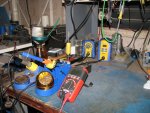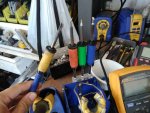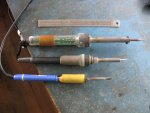- Joined
- Jul 4, 2008
- Messages
- 2,499
- Points
- 113
I'm not really sure, at some time gas powered soldering irons were promoted as suitable for electronics here. These were very small ones though, not suitable for large gauge wires at all.
To me they are mostly fieldwork things, if you have no power available you can resort to using them, probably to restore the power in the first place
As for proper soldering solutions go: Don't spend a lot on them if you are just starting up. Things like the really cheap Aoyue soldering stations are actually not that bad as long as you get the proper tips for them.
The smaller chisel shaped bits that come for those are actually pretty good for general electronics work, and could be used to solder laser diodes easily.
Things like solder suckers or smd tweezers are nice, but not required for general assembly work. You don't need them to remove defective components either, but you might when you want to remove non-defective components for re-purposing or something like that.
Those vacuum solder suckers are good for very fast desoldering and repurposing components. Removing ribbon cables from Laser diodes is super simple and very safe with them.
I tried doing an open can from a LG 20x RW (LPC-826) with one last October and got all the solder off in one go barely subjecting the diode to any heating, just to see if I could do it. (it was a dead drive)
I ended up building it into an Aluminum press fit module and giving it to a classmate.
Last edited:








